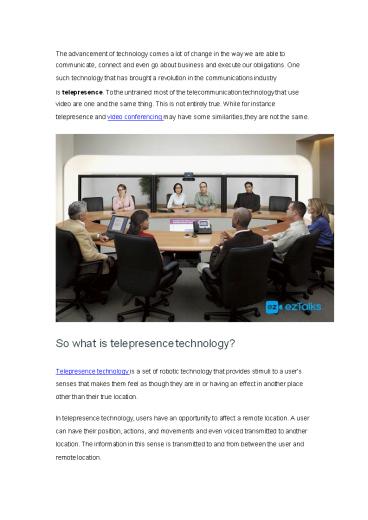What Is Telepresence Technology? PowerPoint PPT Presentation
Title: What Is Telepresence Technology?
1
The advancement of technology comes a lot of
change in the way we are able to communicate,
connect and even go about business and execute
our obligations. One such technology that has
brought a revolution in the communications
industry is telepresence. To the untrained most
of the telecommunication technology that
use video are one and the same thing. This is not
entirely true. While for instance telepresence
and video conferencing may have some
similarities, they are not the same.
So what is telepresence technology?
Telepresence technology is a set of robotic
technology that provides stimuli to a
users senses that makes them feel as though they
are in or having an effect in another place
other than their true location. In telepresence
technology, users have an opportunity to affect a
remote location. A user can have their position,
actions, and movements and even voiced
transmitted to another location. The information
in this sense is transmitted to and from between
the user and remote location.
2
One of the most popular and mainstream
application of telepresence technology is
telepresence video conferencing. This is the most
sophisticated level of video telephony which
allows a very improved sense of fidelity of both
sound and sight than you will have in traditional
video conferencing. It is quite interesting that
mobile telephony technology has made it possible
to move telepresence technology from the
boardroom to allow the use of hand held devices
despite the users location.
How it all started
It all started in a 1948 novel called Waldo. In
the book, the Author writes about his vision for
a remote-controlled economy by suggesting some
form of telepresence master-slave manipulator
system. The idea was later carried in other books
like Brother Assassin. Marvin Minsky, a U.S
cognitive scientist coined the term
telepresence in 1980 in an article that
outlined a concept of teleoperation that can give
a participant a feeling of being in a different
location. Commercially, Teleport-which was later
named TeleSuite-was founded in 1993. This made
it possible for people who would have otherwise
cut short their vacation to actually handle
important business right from where they are.
Hotels like Hilton quickly implemented the
idea. Since the commercialization of the
concept, telepresence has had a wide range of
applications. Applications of the technology
include working in extreme temperatures that may
be hazardous to human life, disarming bombs,
handling of toxic material, remote surgery and
space expeditions.
Other related technology
There are a lot of other technology that
complements telepresence technology. Such include
3
- Videoconference technology. This is any form of
technology that will combine audio and video of
more than one location, exchanging information in
all directions in real-time. - Holographic
telepresence technology uses light to project an
image of a something is a remote area so that
users in that place have the experience of that
person or thing being there with them.
Holographic telepresence achieves the effect of
immersive telepresence which defines just how
real the user feels the remote location they are
in.
Benefits of telepresence
- There are profound benefits that telepresence
affords a business. The main drivers that - influence businesses to choose telepresence
technology in their operations include - Reduction of travel expenses
- Reduction of environmental impact and carbon
footprint - Need to improve productivity by saving time and
resources while encouraging efficiency - The need to improve employee work life balance.
- All the above bring in a lot of time cost
benefits that are superior to just using
traditional phone calls. There is accelerated
problem solution, reduced downtimes, improved
customer service and productivity that comes with
telepresence technology for business
Is telepresence technology expensive?
As is with anything in business, you have to do a
proper cost benefit analysis to determine whether
it is expensive. It just doesnt end with whether
the technology is expensive to acquire and run.
It has a lot to do with how much beneficial it is
to the business in the long run. Being that as
it may, for businesses with multiple locations
and a necessity to handle business in more
places than one, telepresence extends a lot of
benefits to businesses which far outweigh the
initial expense which may be a bit high as
compared to other forms of communication
technology.
4
Any drawbacks?
A common problem with telepresence technology is
usually the level of precision that perception
and detection take place. Harptics and sound
perception require large amounts of bandwidth to
transmit signal. https//www.eztalks.com/video-co
nference/what-is-telepresence-technology.html

